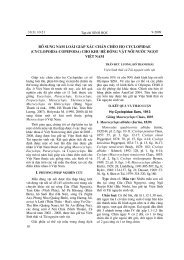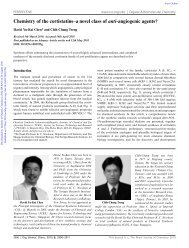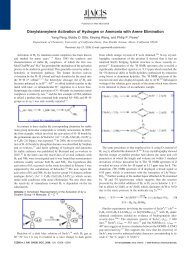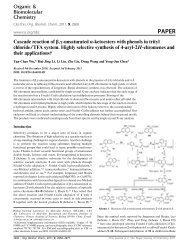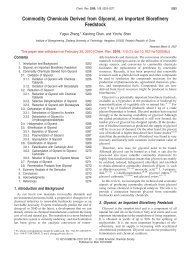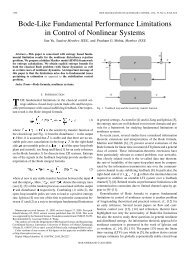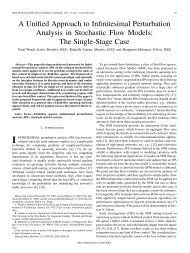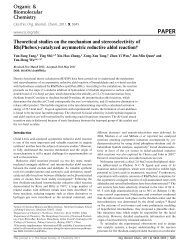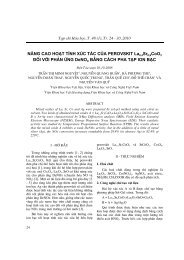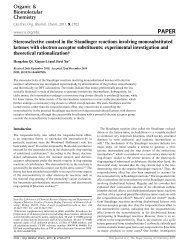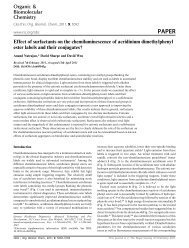uril and cucurbit[8]uril
uril and cucurbit[8]uril
uril and cucurbit[8]uril
You also want an ePaper? Increase the reach of your titles
YUMPU automatically turns print PDFs into web optimized ePapers that Google loves.
PAPER www.rsc.org/obc | Organic & Biomolecular Chemistry<br />
Toxicity of <strong>cucurbit</strong>[7]<strong>uril</strong> <strong>and</strong> <strong>cucurbit</strong>[8]<strong>uril</strong>: an exploratory<br />
in vitro <strong>and</strong> in vivo study<br />
Vanya D. Uzunova, a Carleen Cullinane, b Klaudia Brix, a Werner M. Nau* a <strong>and</strong> Anthony I. Day* c<br />
Received 4th December 2009, Accepted 26th January 2010<br />
First published as an Advance Article on the web 17th February 2010<br />
DOI: 10.1039/b925555a<br />
Cucurbit[n]<strong>uril</strong>s (CB[n]) are potential stabilizing, solubilizing, activating, <strong>and</strong> delivering agents for<br />
drugs. The toxicity of the macrocyclic host molecules <strong>cucurbit</strong>[7]<strong>uril</strong> (CB[7]), the most water-soluble<br />
homologue, as well as <strong>cucurbit</strong>[8]<strong>uril</strong> (CB[8]) has been evaluated. In vitro studies on cell cultures<br />
revealed an IC 50 value of 0.53 ± 0.02 mM for CB[7], corresponding to around 620 mg of CB[7] per kg of<br />
cell material. Live-cell imaging studies performed on cells treated with subtoxic amounts of CB[7]<br />
showed no detrimental effects on the cellular integrity as assessed by mitochondrial activity. For CB[8],<br />
no significant cytotoxicity was observed within its solubility range. The bioadaptability of the<br />
compounds was further examined through in vivo studies on mice, where intravenous administration of<br />
CB[7] showed a maximum tolerated dosage of 250 mg kg -1 , while oral administration of a CB[7]/CB[8]<br />
mixture showed a tolerance of up to 600 mg kg -1 . The combined results indicate a sufficiently low<br />
toxicity to encourage further exploration of CB[n] as additives for medicinal <strong>and</strong> pharmaceutical use.<br />
1. Introduction<br />
Macrocyclic host molecules have the potential to encapsulate biologically<br />
relevant guests <strong>and</strong> act as drug carriers, drug solubilizers,<br />
drug stabilizers, <strong>and</strong> drug bioavailability enhancers. This strategy<br />
has been extensively explored both for naturally occurring hosts<br />
such as cyclodextrins, 1,2 as well as for synthetic molecular receptors<br />
such as calixarenes <strong>and</strong> crown ethers. 3,4 A very promising emerging<br />
class of synthetic molecular hosts are <strong>cucurbit</strong>[n]<strong>uril</strong>s (CB[n]).<br />
CB[n] are macrocyclic containers formed by acid-catalyzed condensation<br />
of n glycol<strong>uril</strong> units with formaldehyde. 5 Although first<br />
made in 1905, 5 the interest towards the CB[n] family has only<br />
grown after the full characterization of the parent compound<br />
<strong>cucurbit</strong>[6]<strong>uril</strong> (CB[6]) in 1981. 6 Subsequently, larger <strong>and</strong> smaller<br />
homologues have been characterized, such that the CB[n] family<br />
nowadays comprises CB[5], CB[6], CB[7], CB[8], <strong>and</strong> CB[10]. 7-10<br />
All CB[n] homologues have highly symmetrical structures with a<br />
hydrophobic cavity, accessible on both sides through two identical<br />
carbonyl-rimmed portals (Fig. 1). They function as molecular<br />
containers forming strong noncovalent 1 : 1 as well as 2 : 1 host–<br />
guest inclusion complexes with neutral <strong>and</strong> positively charged<br />
organic molecules. 10,11<br />
Several biologically <strong>and</strong> pharmaceutically relevant applications<br />
of <strong>cucurbit</strong><strong>uril</strong>s, particularly of CB[7], have been recently<br />
reported. 12–49 With respect to interactions with biomolecules,<br />
<strong>cucurbit</strong><strong>uril</strong>s have been shown to form host–guest inclusion<br />
a School of Engineering <strong>and</strong> Science, Jacobs University Bremen, Campus<br />
Ring 1, D-28759, Bremen, Germany. E-mail: w.nau@jacobs-university.de;<br />
Fax: (49) 4212003229<br />
b Research Division, Peter MacCallum Cancer Centre, Locked Bag No 1,<br />
A’Beckett Street, Melbourne, VIC 8006, Australia. E-mail: carleen.<br />
cullinane@petermac.org; Fax: (61) 396561411<br />
c School of Physical, Environmental <strong>and</strong> Mathematical Sciences,<br />
UNSW@ADFA, Australian Defence Force Academy, Northcott Drive,<br />
Campbell, ACT 2600, Australia. E-mail: a.day@adfa.edu.au; Fax: (61)<br />
262688017<br />
Fig. 1 Structure of <strong>cucurbit</strong>[7]<strong>uril</strong> (CB[7]).<br />
complexes with selected naturally occurring amino acid residues, 12<br />
which has been used to recognize <strong>and</strong> self-sort sequences of<br />
short peptides. 13-17 Cucurbit<strong>uril</strong>–dye reporter pairs have been<br />
successfully employed for assaying the activity of enzymes 18–20<br />
<strong>and</strong> for amino acid sensing. 21 Cucurbit<strong>uril</strong>s have also shown the<br />
potential to bind with either peptide substrates 22 or inhibitors 23<br />
<strong>and</strong> in this way affect the activity of enzymes. Cucurbit<strong>uril</strong>s have<br />
also been employed to immobilize proteins on surfaces by noncovalent<br />
interactions. 24 Furthermore, <strong>cucurbit</strong><strong>uril</strong>s have shown the<br />
capability to refold synthetic oligomers under chemical stimuli<br />
response. 25 The fluorescence enhancement <strong>and</strong> photostabilization<br />
of different dye molecules upon <strong>cucurbit</strong><strong>uril</strong> encapsulation provides<br />
additional potential for biological analysis. These features<br />
are crucial for imaging microscopy applications where improved<br />
biological fluorescence markers are in high dem<strong>and</strong>. This last<br />
strategy has been applied to several commonly used dyes such<br />
as Rhodamine 6G, 26–28 as well as Brilliant Green <strong>and</strong> Neutral Red<br />
in combination with proteins. 29,30<br />
With respect to potential pharmaceutical applications, <strong>cucurbit</strong><strong>uril</strong>s<br />
have also exerted beneficial effects upon interaction with<br />
different classes of drugs. An extensively investigated class of drug<br />
This journal is © The Royal Society of Chemistry 2010 Org. Biomol. Chem., 2010, 8, 2037–2042 | 2037


![uril and cucurbit[8]uril](https://img.yumpu.com/5692724/2/500x640/uril-and-cucurbit8uril.jpg)
